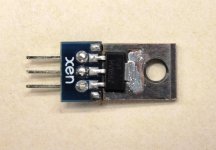Could at least get four amps on that die.
Or an ARM A9 dual core @800MHz with 32k of L1 cache, a total of ~26,000,000 transistors. Design cell is 4.6 sq.mm. and uses 0.5W @1.05V core voltage.
Current M0 core is smaller than a single gate on the original ARM1.
Unfortunately the amps are pad limited due to assembly rules.
^ Ain't lithography great?! (And, well all the other steps, too)
Comes at a price, $1,000,000 mask sets.
I like my analog silicon bigJust fun sometimes to realise how far we have come in such a (relatively) short time.
Had to explain to someone speed/power scales, noise/power does not. We have had requests for 1nV bipolar op-amps that run on 100uA total.
We have had requests for 1nV bipolar op-amps that run on 100uA total.
On-chip buck regulators. Already being done by ARM vendors, allows gaming of the uA/MHz metric.
Had to explain to someone speed/power scales, noise/power does not. We have had requests for 1nV bipolar op-amps that run on 100uA total.
Clarke's 3rd law...
Not sure if you're privy to share (and there might be stuff from IEDM, but I've been out of fab for a few years), but has noise/area remained fairly constant as your nodes have shrunk? I would imagine it's improved in terms of active area with process improvements, but not sure if it has scaled similarly.
Obviously Analog Devices is turning out great new low-noise, um, analog devices,
On-chip buck regulators. Already being done by ARM vendors, allows gaming of the uA/MHz metric.
AFAIK there are no bi-polar op-amps on the same processes as ARM's. Maybe you mis-understood my comment.
Clarke's 3rd law...
Not sure if you're privy to share (and there might be stuff from IEDM, but I've been out of fab for a few years), but has noise/area remained fairly constant as your nodes have shrunk? I would imagine it's improved in terms of active area with process improvements, but not sure if it has scaled similarly.
Obviously Analog Devices is turning out great new low-noise, um, analog devices,but is it because more and more of the die is dedicated to the input transistors?
Actually the rbb values do scale the re component obviously scales directly only the current densities and heat get in the way. With bi-polars it's mostly old school principles. The end result is that a 1nV transistor is a lot smaller on a modern process.
Maybe I did, but buck regulators work on bipolar processes too. My point was that your specified requirement was in uA, not in mW. So if the customer accepts 100uA @ 36V you can use a buck to step that down to 1.2mA @ 3V (efficiency losses not withstanding).
OK I see now, but the request was 100uA at any voltage.
Last edited:
Comes at a price, $1,000,000 mask sets.
Wait till EUV goes into volume production.
Patrick
All low value zeners are spec'd above at 1uV/rthz (60dB). Even those seem to be outstanding as measured on Gerhard's graph.
http://www.nxp.com/documents/data_sheet/PLVA6XXA_SERIES.pdf
And that was 1999.....
No reason not to believe processes has improved since.
But no manufacturer is actually quoting typical values .......
Patrick
You guys are always trying to save a few pennies, while I am trying to get my clients to spring for the more expensive (and better performing) IC or discrete jfets. We live in different worlds.
Right... I had a problem with a guy coming at me for trying to offer a DIY kit cheaper than you could buy the parts yourself, for something that out performs several of Pass's designs at a much lower cost, just because it cost more than a Chinese "version" that can't touch the performance. Could I have made it cheaper in some way? Ya, sure, but why would I want to spend my short time of this planet aspiring for mediocre.
An example of cost-no-issue, for hobby of course.
I wanted to use a high voltage BJT from NXP with excellent specs, but only as SOT223.
Rthjc is quite OK, and I wanted to dissipate more heat than would otherwise be possible with the SMD package.
So I figured out a solution to convert it to TO220.
The difficulty is not in the electrical connection, but mechanical integrity.
After all, the hole assembly has to support the weight of any heat sink one might wish to put on.
Don't ask how much it cost. The backing plate was CNC milled copper.
The 0.8mm PCB was not expensive in comparison.
Patrick
I wanted to use a high voltage BJT from NXP with excellent specs, but only as SOT223.
Rthjc is quite OK, and I wanted to dissipate more heat than would otherwise be possible with the SMD package.
So I figured out a solution to convert it to TO220.
The difficulty is not in the electrical connection, but mechanical integrity.
After all, the hole assembly has to support the weight of any heat sink one might wish to put on.
Don't ask how much it cost. The backing plate was CNC milled copper.
The 0.8mm PCB was not expensive in comparison.
Patrick
Attachments
- Status
- Not open for further replies.
- Home
- Member Areas
- The Lounge
- John Curl's Blowtorch preamplifier part II
